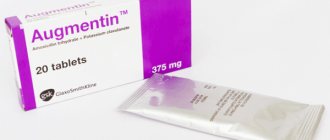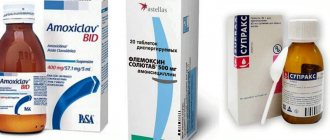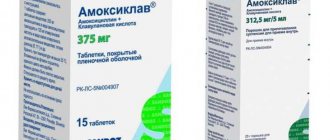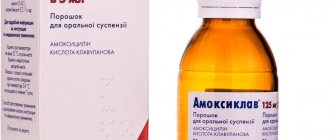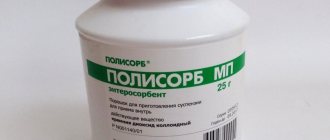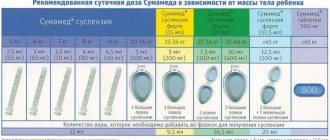The penicillin antibiotic Augmentin is approved for both adults and children. It is prescribed for many infections. But sometimes, young mothers do not wait for the doctor’s recommendations or, on the contrary, act contrary to them, replacing “Augmentin 400” with what the doctor prescribed. In this case, problems may arise with the correct dosage of the Augmentin 400 suspension for children. In order not to cause harm, but to truly benefit from a good and, in many cases, useful drug, you need to understand some of the intricacies.
Return to content
Compound
5 ml of suspension contains:
Active ingredients:
- Amoxicillin trihydrate in terms of amoxicillin 400.0 mg.
- Potassium clavulanate in terms of clavulanic acid 57.0 mg.
Excipients: xanthan gum, aspartame, succinic acid, colloidal silicon dioxide, hypromellose, orange flavor 1, orange flavor 2, raspberry flavor, “Light molasses” flavor, silicon dioxide.
pharmachologic effect
Augmentin is a broad-spectrum antibiotic. The active substances of the drug contribute to the following pharmacological effects:
- Amoxicillin is a semisynthetic antibiotic that is active against gram-negative and gram-positive microbes. The spectrum of action of amoxicillin does not extend to microorganisms that produce the enzyme beta-lactamase.
- Clavulanic acid acts against beta-lactamases and protects amoxicillin from premature destruction by these enzymes. This allows you to expand the antibacterial effect of amoxicillin.
Bacterial microorganisms sensitive to the combination of amoxicillin + clavulanic acid:
- Gram-positive aerobic bacteria: bacilli, fecal enterococci, listeria, nocardia, streptococcal and staphylococcal infections.
- Gram-positive anaerobic bacteria: clostidia, peptostreptococci, peptococci.
- Gram-negative aerobic bacteria: pertussis bacilli, Helicobacter pylori, Haemophilus influenzae, Vibrio cholerae, gonococci.
- Gram-negative anaerobic bacteria: clostridial infections, bacteroides.
Pharmacology
The antibiotic in the drug is suitable for combating many pathogenic microorganisms. The active substance effectively destroys bacteria that cause infectious and inflammatory processes of the skin and subcutaneous tissue, respiratory and genitourinary systems, sepsis, peritonitis and osteomyelitis.
The antibiotic acts by inhibiting the synthesis of pathogenic cells and their walls, but is not capable of independently destroying bacteria that produce certain enzymes. Clavulanic acid, which activates beta-lactamases, helps to expand the effect of amoxicillin, which makes even resistant organisms sensitive to the active substance.
According to the instructions for use, Augmentin 400 is not able to act on salmonella, chlamydia, E. coli, Klebsiella, Protea and others. If these infections are detected in the body, the antibiotic must be replaced. The drug does not help in the treatment of any viral diseases, including chickenpox, influenza and ARVI.
Indications for use
The indication for taking Augmentin is the treatment of bacterial infections that are caused by microorganisms that are sensitive to the components of the drug. Complex therapy for the following diseases:
- Infections of the ENT organs, such as recurrent tonsillitis, sinusitis, otitis media, usually caused by Streptococcus pneumoniae, Haemophilus influenzae, Moraxella catarrhal is and Streptococcus pyogenes.
- Lower respiratory tract infections, such as exacerbations of chronic bronchitis, lobar pneumonia and bronchopneumonia, usually caused by Streptococcus pneumoniae, Haemophilus influenzae and Moraxella catarrhalis.
- Infections of the genitourinary tract, such as cystitis, urethritis, pyelonephritis, infections of the female genital tract, usually caused by species of the family Enterobacteriaceae (mainly Escherichia coli), Staphylococcus saprophyticus and species of the genus Enterococcus, and gonorrhea caused by Neisseria gonorrhoeae.
- Infections of the skin and soft tissues, usually caused by Staphylococcus aureus, Streptococcus pyogenes and Bacteroides species.
- Bone and joint infections, such as osteomyelitis, usually caused by Staphylococcus aureus, when long-term therapy is required.
- Infections caused by microorganisms sensitive to amoxicillin can be treated with Augmentin®, since amoxicillin is one of its active ingredients.
The sensitivity of individual microorganisms to Augmentin may change depending on the patient’s place of residence. If this is possible, then during research it is important to take into account local statistics on the sensitivity of pathogenic microbes.
As necessary, the patient must undergo tests to determine the sensitivity of the pathogen to the antibiotic Augmentin.
Reviews
Moms and dads opinion
Most parents leave positive reviews about Augmentin suspension. They like that it is inexpensive, has a pleasant taste and smell, and comes with a convenient syringe that allows you to accurately dose the medication.
Negative reviews are due to the fact that an allergy to Augmentin is possible.
Komarovsky's opinion
A well-known pediatrician believes that any antibiotic should only be prescribed by a doctor. In this case, it is necessary to take into account the sensitivity of the antimicrobial drug, diagnosis, age of the patient, the presence of concomitant pathologies and a number of other factors. You should only take antibiotics for bacterial infections. If a child drinks while suffering from viral diseases, they can cause serious complications. They are not drunk for prevention.
Augmentin is available by prescription and self-medication is prohibited.
By
Directions for use and dosage
The dosage of Augmentin is selected individually, taking into account the characteristics of the body, age and manifestations of the disease.
In order to reduce the risk of negative effects on the gastrointestinal tract, it is recommended to use the medicine at the beginning of meals. The minimum course of treatment is 5 days.
The drug cannot be taken for more than 14 days without a second examination by the attending physician.
If necessary, two-stage treatment is possible: parenteral administration of the drug (injections) followed by a transition to taking a suspension.
Adults and children over 12 years of age, as well as patients who weigh more than 40 kg, are recommended to take 11 ml of the drug at a dosage of 400 mg + 57 mg 5 ml.
For patients aged 3 months to 12 years who weigh less than 40 kg, the dosage is calculated individually.
There are several options for using the medicine:
- The daily dosage of the medication can be divided into three doses and distributed throughout the day; Augmentin can be taken every 8 hours for a dose of 125 mg/31.25 mg.
- The medication can be taken at a dose of 200 mg/28.5 mg and 400 mg/57 mg twice a day every 12 hours.
Augmentin dosage table (calculation is based on the amoxicillin component)
| Medication dosages | For suspension 4:1 (125 mg/31.25 mg) 3 times a day | For suspension 7:1 (200 mg/28.5 mg and 400 mg/57 mg) 2 times a day |
| Low | 20 mg/kg per day | 25 mg/kg per day |
| High | 40 mg/kg per day | 45 mg/kg per day |
Low dosages can be used in the treatment of infections of soft tissues and skin; with recurrent tonsillitis.
High doses are used in the treatment of otitis media, sinusitis, lower respiratory tract diseases, genitourinary infections, joint and bone diseases.
To date, there are no proper clinical studies regarding recommendations for the use of Augmentin at a dosage of more than 40 mg + 10 mg/kg three times a day for patients under 2 years of age.
For newborns and children under 3 months of age, the recommended dosage is 30 mg/kg per day twice a day in the form of a 4:1 suspension.
For children born prematurely, there are no instructions regarding the dosage regimen.
For patients with severe renal impairment, the following dosages are recommended:
| Creatinine clearance rate, ml/min | For suspension 4:1 (125 mg/31.25 mg) three times a day | For 7:1 suspension (200 mg/28.5 mg and 400 mg/57 mg) twice daily |
| Over 30 | No need to adjust dose | No need to adjust dose |
| 10-30 | 15 mg + 3.75 mg/kg twice daily. Maximum dosage – 500 mg + 1.25 mg twice a day | – |
| Less than 10 | 15 mg + 3.75 mg/kg per day. Maximum dosage – 500 mg + 1.25 mg per day | – |
Patients on hemodialysis are recommended to take the drug at a dose of 15 mg + 3.75 mg/kg per day.
Before starting the hemodialysis procedure, an additional dose of the drug 15 mg + 3.75 mg/kg is required.
In order to replenish the required concentration of the active components of the drug Augmentin in the blood, repeated administration of an additional dose of 15 mg + 3.75 mg/kg is required after the end of the hemodialysis procedure.
How to take Augmentin for children
- from birth to three months, the excretory system has not yet fully formed, so the dose should be minimal - thirty milligrams of amoxicillin per kilogram of body weight twice a day, in the form of a suspension;
- over three months and up to twelve years, the dosage is forty milligrams per kilogram of weight before breakfast, lunch and dinner.
If a child has kidney problems, the doctor carefully adjusts the dosage.
In this case, the suspension must be diluted correctly:
- use only clean boiled water – preferably filtered;
- first pour half the required amount of water, add the powder, shake vigorously;
- add the second half exactly to the mark, shake again.
It must be remembered that the suspension will not be transparent and clean - the antibiotic does not completely dissolve in water. You need to store the finished medicine in the refrigerator and keep in mind that it is enough for only one course of administration - after three weeks the antibiotic will break down and the remains can only be thrown away.
Rules for preparing the suspension
The suspension is prepared immediately before the first use.
Add approximately 60 ml of boiled water, cooled to room temperature, to the bottle with the powder, then close the bottle with a lid and shake until the powder is completely diluted, let the bottle stand for 5 minutes to ensure complete dilution. Then add water up to the mark on the bottle and shake the bottle again. In total, about 92 ml of water is required to prepare the suspension.
The bottle should be shaken well before each use. For accurate dosing of the drug, you should use a measuring cap, which must be rinsed well with water after each use. After dilution, the suspension should be stored for no more than 7 days in the refrigerator, but not frozen.
For children under 2 years of age, a measured single dose of Augmentin suspension can be diluted by half with water.
Augmentin general characteristics of the drug
The main components of Augmentin, regardless of its release form, are the antibiotic amoxicillin and the lactamase liquidator clavullinic acid. The main burden lies on amoxicillin: it is thanks to it that the drug has an antibacterial effect against almost any infection. However, it has a significant drawback - most pathogenic microorganisms quickly get used to it and stop responding, as a result of which an additional component is needed that will destroy the resistance of viruses. This component is clavullinic acid.
Amoxicillin belongs to the group of penicillins and is in most cases well tolerated, as a result of which it can be used in therapy in young children and pregnant women, but has a number of side effects. In addition, it is not approved for use in patients with phenylketonuria, renal failure and liver dysfunction.
The main indications for taking Augmentin suspension are:
- Infectious diseases of the respiratory tract in any form, including relapse of chronic conditions;
- Infectious diseases of the genitourinary system;
- Skin diseases caused by infection;
- Osteomyelitis;
- Prevention of infections after surgery.
For administration, the Augmentin suspension is prepared according to the following algorithm:
- The powder is poured into a bottle, after which it is poured with warm (not hot!) water, which must be boiled before;
- The bottle is shaken to dissolve the granules as much as possible and left for 4-5 minutes. until the particles of the substance are completely dissolved. If this does not happen, the container must be shaken again and set aside;
- Add water up to the marks on the inside of the bottle;
- After this, the suspension is ready for use. It can be kept refrigerated, if not frozen, for 7 days, but it is recommended to use it sooner. It is prohibited to use the suspension on day 8, even if visually it has not changed its properties;
- Before use, the bottle of liquid is shaken and the required volume is poured into a measuring spoon or drawn up with a syringe. Be sure to wash any item thoroughly after use, avoiding the accumulation of drug particles on the surface;
- If necessary, it is allowed to dilute the liquid with warm boiled water in equal proportions, but the child will have to drink an increased volume, and not half of it;
The approximate price of the Augmentin 400 suspension ranges from 380-460 rubles.
- Echinacea for children
- Troychatka from temperature: composition, application, dosage
Adverse reactions
Augmentin may contribute to the development of the following unwanted side effects:
- Candidiasis of mucous membranes and skin.
- Diarrhea, nausea and vomiting.
- Headache, dizziness.
- Skin itching, urticaria, rash.
If allergic reactions develop, treatment with Augmentin should be stopped immediately.
It is necessary to inform your doctor about developing side effects in order to adjust the dosage or select symptomatic therapy.
Overdose
In case of overdose, the development of undesirable side reactions from the gastrointestinal tract and disturbances in water and electrolyte balance is possible. The likelihood of developing seizures increases in patients with impaired renal function and in individuals who received a high dose of medication.
If an overdose occurs, you should immediately consult a doctor to prescribe symptomatic therapy aimed at normalizing the functioning of the gastrointestinal tract and restoring water and electrolyte balance. The active components of Augmentin are removed from the body using hemodialysis.
Showing
Treating adults and children for bacterial infections caused by microorganisms sensitive to Augmentin, such as:
- acute bacterial sinusitis (confirmed);
- acute otitis media;
- confirmed chronic chronic bronchitis;
- non-hospital pneumonia;
- cystitis;
- pyelonephritis;
- infections of the skin and soft tissues, incl. cellulitis, animal bites, severe dentoalveolar abscesses with widespread cellulitis;
- Infections of the cysts and mucous membranes, incl. osteomyelitis.
When using antibacterial drugs, follow the rules for their proper stagnation.
Drug interactions
The simultaneous use of Augmentin and probenecid is not recommended. Probenecid reduces the tubular secretion of amoxicillin, and therefore the simultaneous use of Augmentin and probenecid may lead to an increase and persistence in the blood concentration of amoxicillin, but not clavulanic acid.
Concomitant use of allopurinol and amoxicillin may increase the risk of allergic skin reactions. Currently, there is no data in the literature on the simultaneous use of a combination of amoxicillin with clavulanic acid and allopurinol. Penicillins can slow down the elimination of methotrexate from the body by inhibiting its tubular secretion, so the simultaneous use of Augmentin and methotrexate may increase the toxicity of methotrexate.
Like other antibacterial drugs, Augmentin can affect the intestinal microflora, leading to a decrease in the absorption of estrogens from the gastrointestinal tract and a decrease in the effectiveness of combined oral contraceptives.
Additional recommendations
Before starting the use of Augmentin, it is necessary to collect the patient's medical history in order to identify possible hypersensitivity reactions to penicillin, cephalosporin and other components.
Taking Augmentin suspension may stain the patient's teeth. To avoid the development of such an effect, it is enough to follow the basic rules of oral hygiene - brushing your teeth, using mouthwash.
Taking Augmentin can cause dizziness, so during therapy you should refrain from driving vehicles and performing work that requires increased concentration.
Augmentin cannot be used if an infectious form of mononucleosis is suspected.
Augmentin is well tolerated and has low toxicity. If long-term use of the medicine is required, then it is necessary to periodically check the functioning of the kidneys and liver.
Contraindications
Augmentin suspension is contraindicated for a child if he or she has the following abnormalities:
- hypersensitivity to the composition of the drug and β-lactam antibiotics;
- phenylketonuria;
- renal dysfunction, in which the renal blood flow rate is 30 ml per minute;
- jaundice or liver dysfunction caused by treatment with amoxicillin and clavulanic acid.
The drug should be prescribed with caution to children with liver pathologies; their function should be monitored throughout the course of antibiotic therapy.
